Abstract
Cajanus cajan (L) Millsp. (Sanskrit: Adhaki, Hindi: Arhar, English: Pigeon pea, Bengali: Tur) (family: Fabaceae) is the most important grain legume crop of rain-fed agriculture in semi-arid tropics. It is both a food crop and a cover/forage crop with high levels of proteins and important amino acids like methionine, lysine and tryptophan. During the last few decades extensive studies have been carried out regarding the chemistry of C. cajan and considerable progress has been achieved regarding its biological activities and medicinal applications. This review article gives an overview on the biological activities of the compounds isolated, pharmacological actions and clinical studies of C. cajan extracts apart from its general details.
Keywords: Arhar, biological and medicinal properties, Cajanus cajan, fabaceae, pigeon pea
INTRODUCTION
Throughout history plants have been used by human beings for medicinal purposes and even in modern times have formed the basis of many pharmaceuticals in use. Plants produce a vast array of secondary metabolites as defense against environmental stress or other factors like pest attacks, wounds, and injuries. The complex secondary metabolites produced by plants have found various therapeutic uses in medicine from time immemorial.[1–3] The early history of modern medicine contains descriptions of plant-derived phytochemicals, many of which are still in use.[4–6] Cajanus cajan (L) Millsp. (In Sanskrit: Adhaki, Hindi: Arhar, English: Pigeon pea, Bengali: Tur) [Figures 1 and 2] is a perennial member of the family fabaceae. Other common names are red gram, congo pea, gungo pea, and no-eye pea.[7] The cultivation of arhar goes back at least 3000 years. The centre of origin is most likely Asia, from where it travelled to East Africa and by means of the slave trade to the American continent. It is an erect, branched, hairy shrub, 1-2 meters high. Leaves are oblong-lanceolate to oblanceolate with three leaflets. Flowers are yellow, in sparse peduncled racemes, about 1.5-cm long. Pod is hairy, 4-7 cm long, 1 cm wide, containing two to seven seeds. India is a principal pigeon pea-growing country contributing nearly 90% of the total world production. Currently, it occupies an area of 3.85 million hectares with an annual production of 2.68 million tones.[8] It is a multipurpose plant as it is extensively eaten as a dal. It is rich in proteins. In India its leaves are used for rearing silkworms; green pods are used as a vegetable; husk, green leaves and tops are used as fodder and also as green manure.[9] Amongst its many medicinal uses, C. cajan is indicated in the relief of pain in traditional Chinese medicine and as a sedative.[10] In recent years it has also been explored for the treatment of ischemic necrosis of the caput femoris, aphtha, bedsore and wound healing. Chemical investigations have revealed the presence of two globulins, cajanin and concajanin.[9] It has been used widely for many years for treating diabetes, sores, skin irritations, hepatitis, measles, jaundice, dysentery and many other illnesses; for expelling bladder stones and stabilizing menstrual period.[11]
Figure 1.
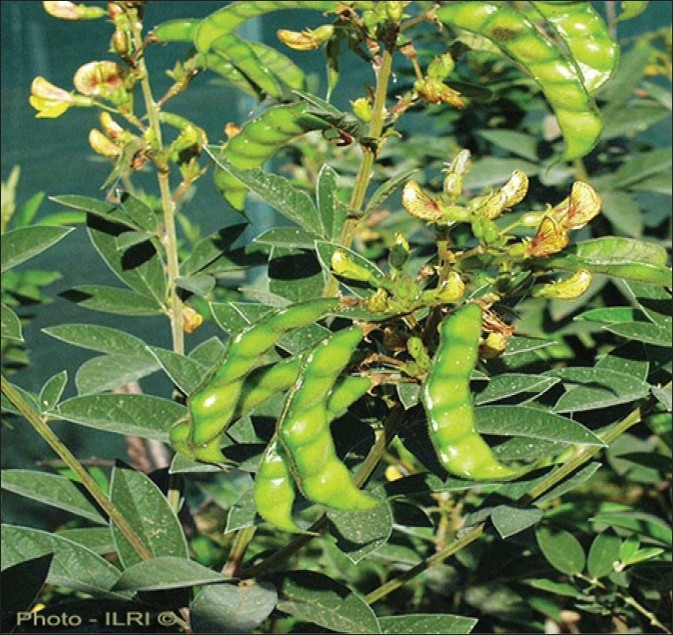
Leaves, fruits and flowers of C. cajan
Figure 2.
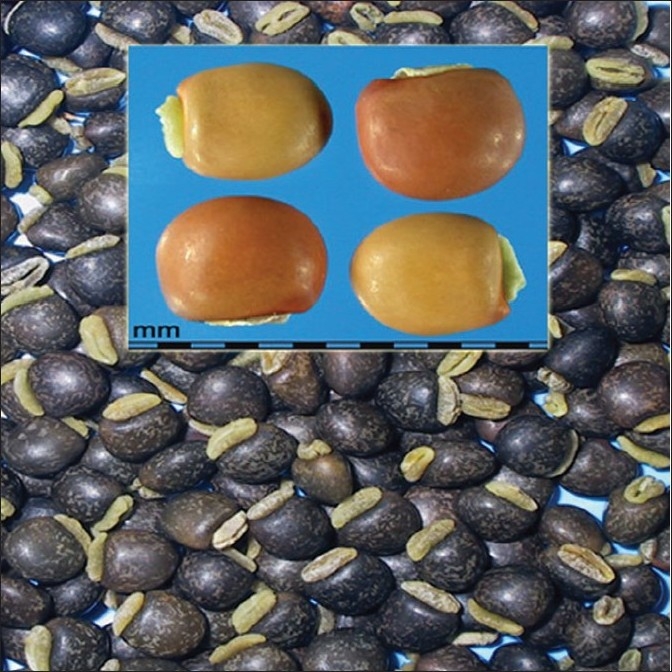
Mature fruits of C. cajan
GEOGRAPHICAL SOURCE
It has been cultivated in ancient Egypt, Africa and Asia since prehistoric times, and was later introduced to America. Now it acclimatizes in several tropical countries. The major producer is India contributing about 90% of world production. Its altitude range is 1250 m in Hawaii, 0-3000 m in India and Columbia. It is essentially a plant of the semi-dry lowlands but has wide adaptability.[12]
CULTIVATION
C. cajan thrives best in seed beds prepared by deep plaguing and cultivating to reduce weeds. It usually responds to phosphorus, and requires enough calcium, potash, and magnesium. It is sown in rows for inter-row cultivation and mechanical harvesting. It can be seeded in holes about 2 m apart; in India it is usually sown in alternate rows with sesame, in Malawi with maize and in Hawaii with forage grasses. Seedling is fairly slow to start and weed control for the first two months of growth considerably improves its performance.[13]
ETHNOPHARMACOLOGICAL IMPORTANCE
C. cajan being a forage crop has been utilized as an important remedy for various ailments. The garo tribal community of Bangladesh utilizes it for the treatment diabetes and as an energy stimulant.[1] In Trinidad and Tobago the leaves of C. cajan are used in food poisoning, as colic and in constipation.[14] In Chinese folk medicine pigeon pea leaves are used to staunch blood, as an analgesic and to kill parasites. In some parts of Tamil Nadu, India, the leaf, seeds and young stems are used to cure gingivitis, stomatitis and as a toothbrush.[15] It is also an important folk medicine in eastern Rajasthan as fresh juice/boiled leaves are given orally to nullify the effect of intoxication and as a laxative. Leaf paste is applied in oral ulcers and inflammations. Leaves and seeds are applied as poultice over the breast to induce lactation.[16] The major ethnopharmacological details have been summarized in Table 1.
Table 1.
Ethnopharmacological uses of C. cajan
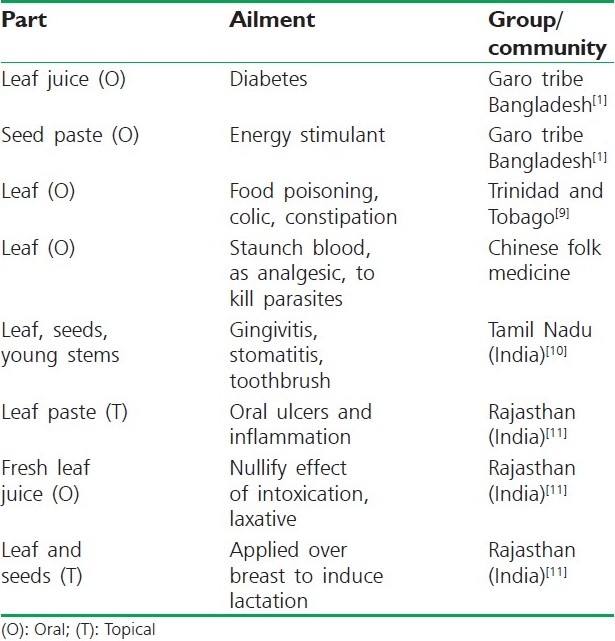
CHEMISTRY
Chemical constituent investigations have indicated that C. cajan leaves are rich in flavonoids and stilbenes. They also contain saponins, conspicuous amount of tannins, and moderate quantities of reducing sugars, resins and terpenoids. Chemical studies reveal 2’-2’ methyl cajanone, 2’-hydroxy genistein, isoflavones, cajanin [Figure 3], cahanones etc., which impart antioxidant properties.[17] Roots are also found to possess genistein and genistin. It also contains hexadecanoic acid, α amyrin, β-sitosterol, Pinostrobin [Figure 4], longistylin A [Figure 5] and longistylin C [Figure 6] which impart anticancer activity. Presence of cajanuslactone [Figure 7], a coumarin imparts antibacterial activity. Presence of cajaninstilbene acid [Figure 8], pinostrobin, vitexin [Figure 9] and orientin [Figure 10] is responsible for antiplasmodic activity.
Figure 3.
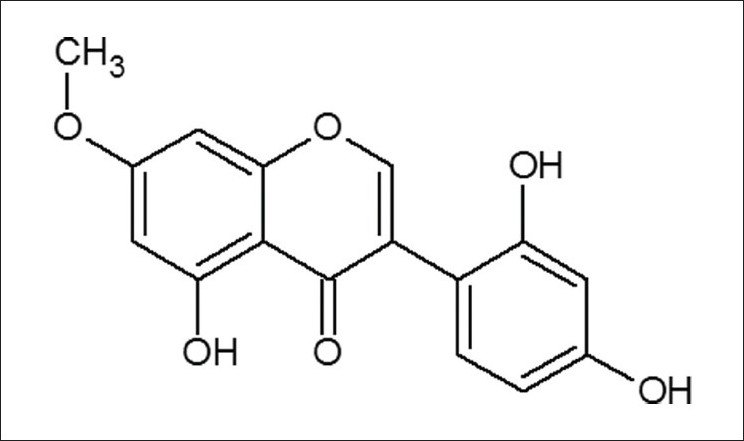
Structure of cajanin
Figure 4.
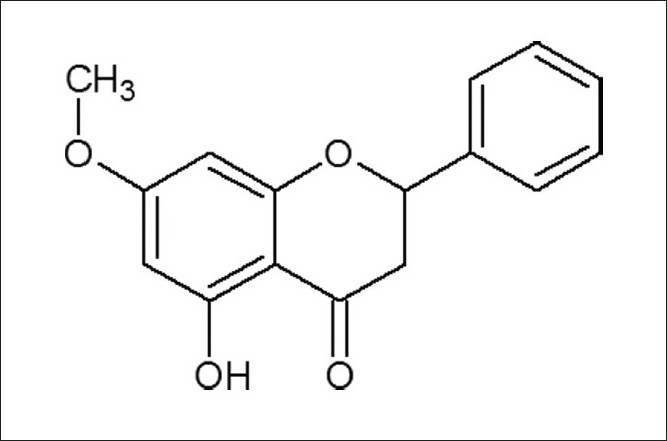
Structure of pinostrobin
Figure 5.
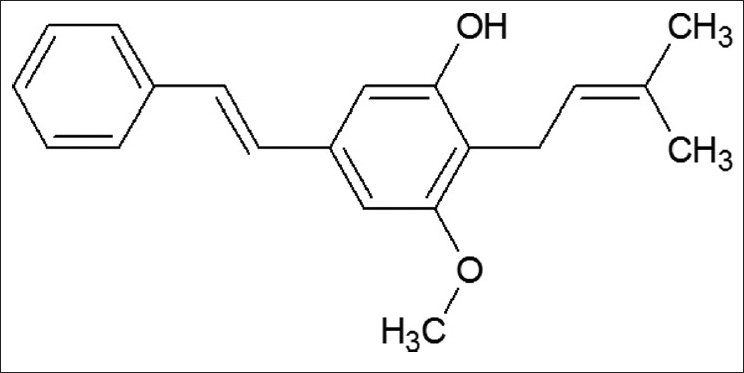
Structure of longistylin A
Figure 6.
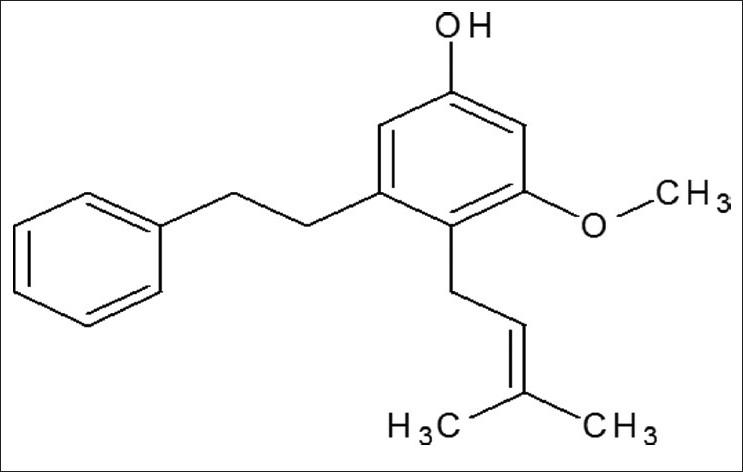
Structure of longistylin C
Figure 7.
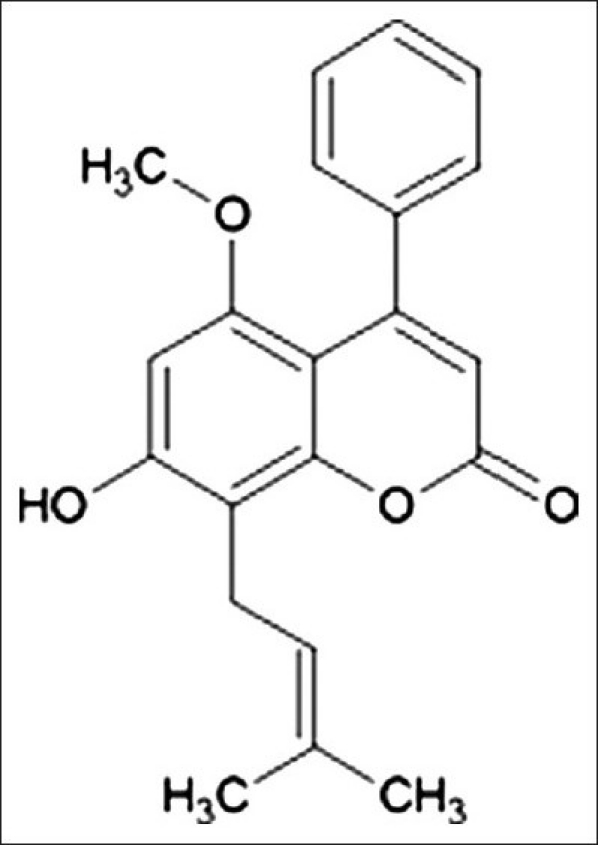
Structure of cajanuslactone
Figure 8.
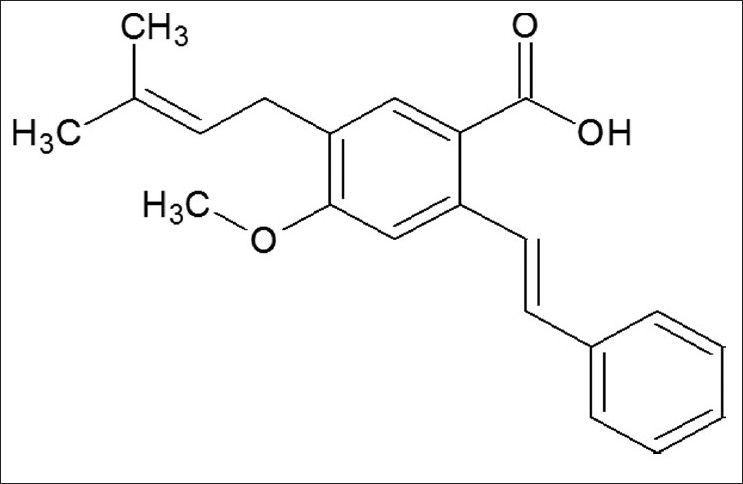
Structure of cajaninstilbene acid
Figure 9.
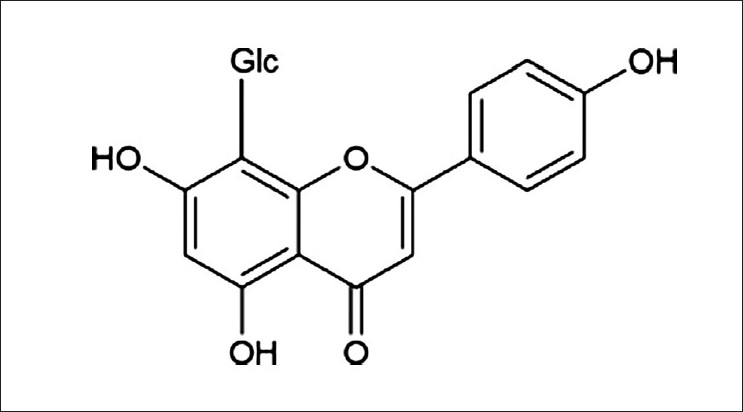
Structure of vitexin
Figure 10.
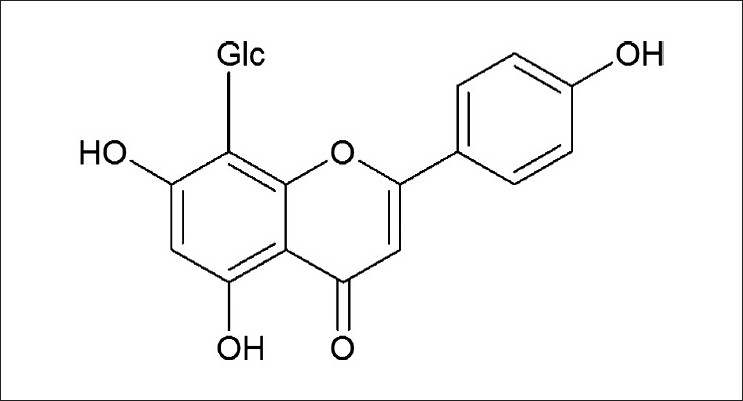
Structure of orientin
BIOLOGICAL ACTIVITIES OF SOME COMPOUNDS
During the last few decades a large number of compounds have been isolated from C. cajan and some of them have got excellent biological activities. A new natural coumarin cajanuslactone has been isolated from the leaves of C. cajan which is a potential antibacterial agent against Gram-positive micro-organisms.[18] The three stilbenes, cajanin, longistylin C and longistylin A from leaves have been found to possess hypocholesterolemic effects.[19] Anti-plasmodial activities have also been confirmed in betulinic acid isolated from roots and longistylin A and C obtained from leaves.[20] Pinostrobin, a substituted flavanone isolated from leaves possesses anti-inflammatory activity and inhibits sodium channel-activated depolarization of mouse brain synaptoneurosomes.[21] Two isoflavanoids genistein and genistin isolated from the roots were found to possess antioxidant activity.[22] Cajanol [Figure 11] an isoflovanone found in the roots is found to possess anticancer activity.[23] Four important compounds, pinostrobin, cajaninstilbene acid, vitexin and orientin isolated from ethanolic extracts of leaves were found to possess significant antioxidant properties.[7] Isoflavanoids isolated from ethanolic extract of leaves also showed significant antimicrobial activities.[11] Some protein fraction isolated from leaves also showed hepato-protective effects[24] and the presence of phenolics (flavanoids and tannins) impart anthelmintic activity.[25] The major chemical constituents and their biological activities are summarized in Table 2.
Figure 11.
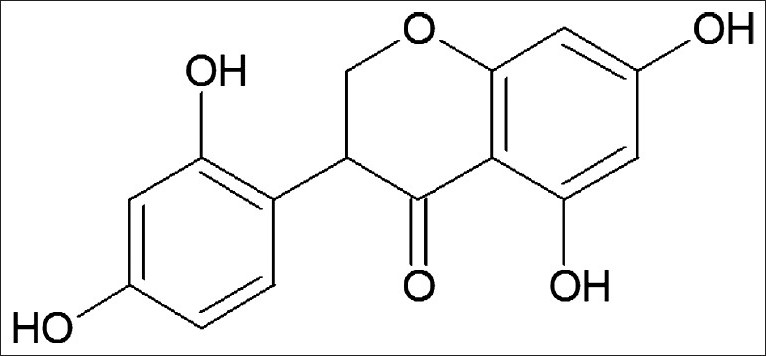
Structure of cajanol
Table 2.
Pharmacological activities and active constituents of C. cajan
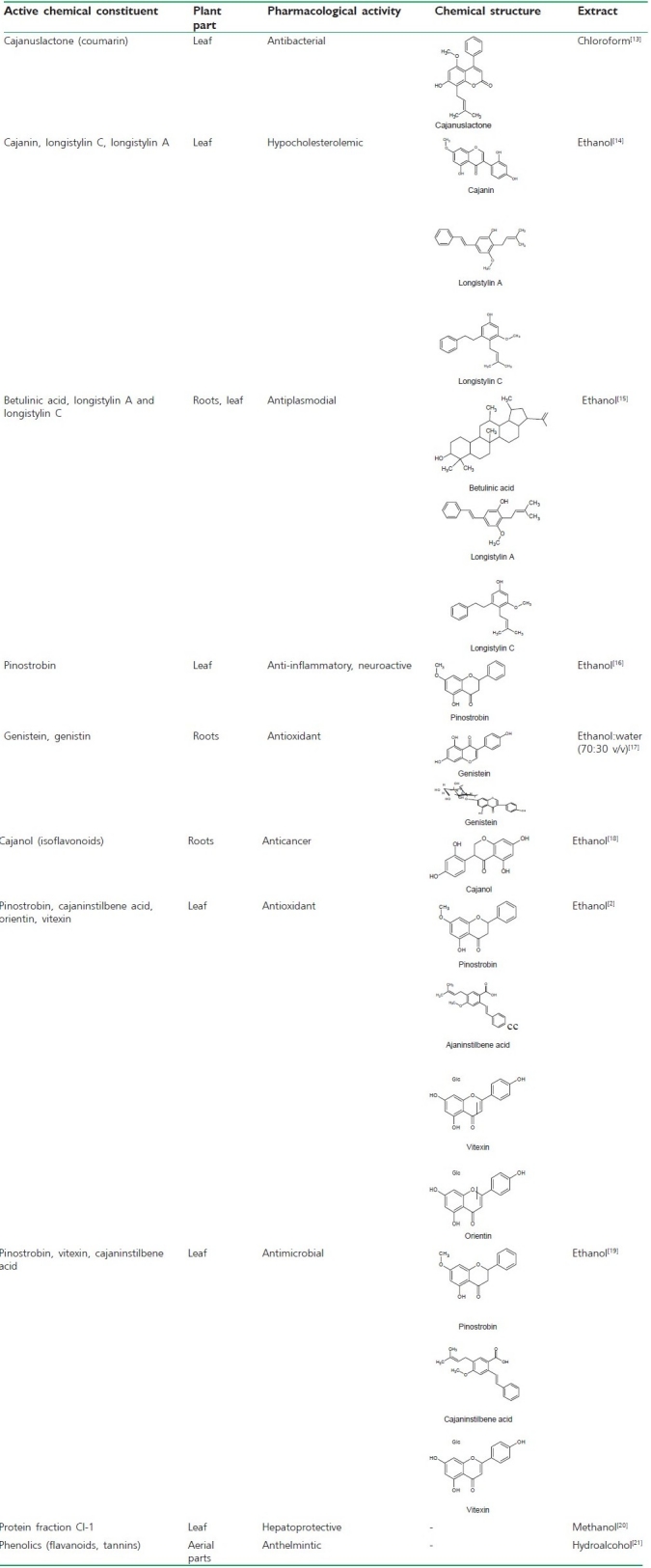
PHARMACOLOGICAL ACTIONS
Different parts of C. cajan have been utilized for their biological activities since time immemorial and some of them have experimental grounds for their acceptance. Apart from their uses in folkloric medicines, there are several reports on the biological activities and pharmacological actions of C. cajan based on modern scientific investigations.
Antimicrobial Activity
The in vitro and in vivo antimicrobial activities of SFE-CO2 (supercritical fluidextraction) extracts and ethanol extracts from C. cajan were investigated. In vitro antimicrobial activities of the extracts were evaluated against eight microbial strains: Staphylococcus epidermidis, Staphylococcus aureus, Bacillus subtilis, Proteus vulgaris, Pseudomonas aeruginosa, Escherichia coli, Aspergillus niger and Candida albicans. A marked inhibitory effect of the SFE extracts was observed against S. epidermidis, S. aureus and B. subtilis. In vivo antimicrobial activity was studied in mice that had been inoculated with S. aureus and the potential mechanism of antimicrobial activity was studied by histopathology.[11]
Antibacterial Activity
The bioassay-guided fractionation of chloroform extract from pigeon pea leaves led to isolation of new natural coumarins: Cajanuslactone and two phyto alexins: Pinostrobin and cajaninstilbene acid. It was found that cajanuslactone possessed good antibacterial activity against S. aureus.[17]
Hypocholesterolemic Effects
The effects of the stilbenes containing extract-fraction from C. cajan (SECC) on diet-induced hypercholesterolemia in kunming mice were identified. The SECC reduced the atherogenic properties of dietary cholesterol in mice. Its hypocholesterolemic effect may involve enhancement of the hepatic Low Density Lipoprotein-receptor and cholesterol-7-alpha-hydroxylase expression levels and bile acid synthesis.[19]
Antidiabetic Effects
The antidiabetic activity of methanolic extract of leaves of C. cajan was studied in alloxan-induced diabetic and oral glucose-loaded rats. The acute toxicity and lethality (LD50) and phytochemical analysis of the extract were also evaluated.[26,27] The results showed that the extract significantly reduced the fasting blood sugar of alloxan diabetic rats in a dose-related manner with maximum hypoglycemic effect at 4-6 h.[20,28]
Neuroactive Properties
In vitro neuroactive properties of pinostrobin, a substituted flavanone from C. cajan were estimated. It was demonstrated that pinostrobin inhibits voltage-gated sodium channels of mammalian brain based on the ability of this substance to suppress the depolarizing effects of the sodium channel selective activator veratridine in a synaptoneurosomal preparation from mouse brain. The pharmacological profile of pinostrobin resembles that of depressant drugs that block sodium channels.[21]
Antioxidant Activities
Antioxidant activities of the aqueous, ethanol, ethyl acetate, n-butanol, petroleum ether extracts of C. cajan leaves and the four main compounds separated from the ethanol extract, i.e. cajaninstilbene acid (3-hydroxy-4-prenylmethoxystilbene-2-carboxylic acid), pinostrobin, vitexin and orientin, were examined by 2,2-diphenyl-1-picrylhydrazyl (DPPH) radical-scavenging assay[29–31] and β-carotene-linoleic acid test. Based on the results obtained, it was concluded that the pigeon pea leaf extracts may be valuable natural antioxidants and potentially applicable to medicine and the health food industry.[7] A new method–negative pressure cavitations extraction (NPCE)–was also proposed and extraction for the main isoflavonoids, namely genistein and genistin from pigeon pea roots was suggested. NPCE extract possessed notable concentration-dependent antioxidant activity.[27]
Anticancer Activity
Cajanol, an isoflavanone from C. cajan roots is an important phytoalexin. The anticancer activity of cajanol towards MCF-7 human breast cancer cells was investigated. In order to explore the mechanism of cell growth inhibition of cajanol some parameters like cell cycle distribution, DNA fragmentation assay and morphological assessment of nuclear change, reactive oxygen species (ROS) generation, mitochondrial membrane potential disruption and expression of caspase-3 and caspase-9, Bcl-2, PARP and cytochrome c were measured. Cajanol inhibited the growth of MCF-7 cells in a time- and dose-dependent manner. Cajanol arrested the cell cycle in the G2/M phase and induced apoptosis via a reactive oxygen species (ROS) -mediated mitochondria-dependent pathway.[23]
Hepatoprotective Effects
The methanol extracts of C. cajan were studied for hepatoprotective activity against Swiss albino mice with liver damage induced by carbon tetrachloride (CCl4). It was found that the same extract exhibited a moderate protective effect by lowering the serum levels of alanine aminotransferase (ALT) or serum glutamate pyruvate transaminase (SGPT), aspartate aminotransferase (AST) or serum glutamate oxaloacetate transaminase (SGOT), and cholesterol to a significant extent.[24] The methanol-aqueous fraction (MAF2) of the leaf extract was also used to prevent alcohol induced rat liver damage. Co- administration of MAF2 reversed the liver damage; it decreased the activities of liver marker enzymes and augmented antioxidant enzyme activities and showed a promise in therapeutic use in alcohol-induced liver dysfunction.
Anthelmintic Activity
The hydro-alcoholic extracts of the aerial parts of C. cajan were evaluated for anthelmintic properties using Indian adult earthworm (Pheretima posthuma) due to their anatomical and physiological resemblance with intestinal parasites and round worms.[32,33] This property was supposed to be due to the presence of phenolics (flavanoids and tannins) which are reported to have good anthelmintic property.[25]
Glycemic Activity
The glycemic profile of the aqueous extract of C. cajan leaves in streptozocin-induced Type 2 diabetic rats was evaluated. This extract showed significant increment in fasting blood glucose levels of normal rats. The study of leaves was taken into consideration on the basis of earlier reported hypoglycemic activity of C. cajan seeds. However, the results observed were found to be just opposite and therefore it may be useful in controlling hypoglycemia occasionally caused due to excess of insulin and other hypoglycemic drugs.[28]
CONCLUSION
Being a rich source of protein and a most important forage crop, C. cajan is the most widely used and cultivated crop. It has also been used traditionally in many parts of the world for its innumerable medicinal properties but still its identity as a medicinal plant is not established. To date, several flavonoids, isoflavonoids, tannins and protein fractions have been isolated from its different parts and their medicinal uses have been established, but many bioactive constituents and pure compounds have so far been neglected by phytochemists and pharmacologists and a large amount of work has been done only on extracts and not the isolated fractions which shows scope for further study in this direction. The present review article aims at focusing the attention of research scholars on the unexplored and untouched areas related with C. cajan and may act as an important step towards the establishment of C. cajan (L) Millsp. as a medicinal drug.
Footnotes
Source of Support: Nil
Conflict of Interest: Nil.
REFERENCES
- 1.Pal D, Sarkar A, Gain S, Jana S, Mandal S. CNS depressant activities of Coccos nucifera in mice. Acta Pol Pharm. 2011;68:249–54. [PubMed] [Google Scholar]
- 2.Pal DK, Mandal M, Senthilkumar GP, Padhiari A. Antibacterial activity of Cuscuta reflexa stem and Corchorus olitorius seed. Fitoterapia. 2006;77:589–91. doi: 10.1016/j.fitote.2006.06.015. [DOI] [PubMed] [Google Scholar]
- 3.Pal DK, Pahari SK, Pathak AK. Evaluation of CNS activities of aerial parts of Jasminum multiflorum Andr. Asian J Chem. 2007;19:4452–8. [Google Scholar]
- 4.Pal DK, Sannigrahi S, Mazumder UK. Analgesic and anticonvulsant effects of saponin isolated from the leaves of Clerodendrum infortunatum Linn. In mice. Indian J Exp Biol. 2009;47:743–7. [PubMed] [Google Scholar]
- 5.Pal DK, Sahoo M, Mishra A. Analgesic and anticonvulsant effects of saponin isolated from the stems of Opuntia vulgaris Mill in mice. Euro Bull Drug Res. 2005;13:91–7. [Google Scholar]
- 6.Mohammed R, Jahan MI, Fahmidul HA, Haque M. An ethnobotanical survey and pharmacological evaluation of medicinal plants used by the Garo tribal community living in netrakona district Bangladesh. Adv Nat Appl Sci. 2009;3:402–18. [Google Scholar]
- 7.Wu N, Fu K, Fu YJ, Zu YG, Chang FR, Chen YH, et al. Antioxidant activities of extracts and main components of pigeon pea leaves. Molecules. 2009;14:1032–43. doi: 10.3390/molecules14031032. [DOI] [PMC free article] [PubMed] [Google Scholar]
- 8.Kumar H, Bajpai VK, Dubey RC, Maheshwari Kang SC. Wilt disease management and enhancement of growth and yield of C.cajan by bacterial combinations amended with chemical fertilizers. Crop prot. 2010;29:591–8. [Google Scholar]
- 9.Ambasta SP. 4th ed. New Delhi: National Institute of Science Communication; 2004. The useful plants of India; pp. 94–5. [Google Scholar]
- 10.Ahsan R, Islam M. In vitro antibacterial screening and toxicological study of some useful plants (Cajanus cajan) Euro J Sci Res. 2009;41:227–32. [Google Scholar]
- 11.Yuan-gang Zu, Xiao-lei , Yu-jie Fu, Nan Wu, YuKong, Michael W. Chemical composition of the SFE-CO2 extracts from Cajanus cajan (L.) Huth and their antimicrobial activity in vitro and in vivo. Phytomed. 2010;17:1095–101. doi: 10.1016/j.phymed.2010.04.005. [DOI] [PubMed] [Google Scholar]
- 12.Duke JA. NewYork: Plenum Press; 2004. Handbook of legumes of world economic importance; pp. 33–7. [Google Scholar]
- 13.Morton JF. The pigeon pea (Cajanus cajan Millsp.), a high protein tropical bush legume. Hort Sci. 1976;11:11–9. [Google Scholar]
- 14.Lans C. Comparison of plants used for skin and stomach problems in Trinidad and Tobago with Asian Ethnomedicine. J Ethnobiol Ethnomed. 2007;33:22–8. doi: 10.1186/1746-4269-3-3. [DOI] [PMC free article] [PubMed] [Google Scholar]
- 15.Ganeshan S. Traditional oral care medicinal plants survey of Tamil nadu. Nat Prod Rad. 2008;7:166–72. [Google Scholar]
- 16.Upadhyay B, Parveen, Dhaker AK, Kumar A. Ethnomedicinal and ethnopharmaco - statistical studies of Eastern Rajasthan, India. J Ethnopharmacol. 2010;129:64–86. doi: 10.1016/j.jep.2010.02.026. [DOI] [PubMed] [Google Scholar]
- 17.Kong Y, Fu YJ, Zu YG, Chang FR, Chen YH, Liu XL, et al. Cajanuslactone a new coumarin with anti bacterial activity from pigeon pea leaves. Food Chem. 2010;121:1150–5. [Google Scholar]
- 18.Luo QF, Sun L, Si JY, Chen DH. Hypocholesterolemic effect of stilbenes containing extract fraction from Cajanus cajan on diet induced hypercholesterolemia in mice. Phytomedicine. 2008;15:932–9. doi: 10.1016/j.phymed.2008.03.002. [DOI] [PubMed] [Google Scholar]
- 19.Luo QF, Sun L, Si JY, Chen DH. Hypocholesterolemic effect of stilbenes containing extract fraction from Cajanus cajan on diet induced hypercholesterolemia in mice. Phytomed. 2008;15:932–9. doi: 10.1016/j.phymed.2008.03.002. [DOI] [PubMed] [Google Scholar]
- 20.Ezike AC, Akah PA, Okoli CC, Okpala CB. Experimental evidence for the antidiabetic activity of Cajanus cajan leaves in rats. J Basic and Clinical Pharm. 2010;1:25–30. [PMC free article] [PubMed] [Google Scholar]
- 21.Nicholson RA, David LS, Pan RL, Xin Min Liu. Pinostrobin from Cajanus cajan (L.) Millsp. Inhibits sodium channel-activated depolarization of mouse brain synaptoneurosomes. Fitoterapia. 2010;81:826–9. doi: 10.1016/j.fitote.2010.05.005. [DOI] [PubMed] [Google Scholar]
- 22.Zhang DY, Zhang S, Zu YG, Fu YJ, Kong Y, Gao Y, et al. Negative pressure cavitation extraction and antioxidant activity of genistein and genistin from the roots of pigeon pea. Separation and Purification Tech. 2010;74:261–70. [Google Scholar]
- 23.Luo M, Liu X, Zu Y, Fu Y, Zhang S, Yao L, et al. Cajanol, a novel anticancer agent from Pigeonpea [Cajanus cajan (L.) Millsp.] roots, induces apoptosis in human breast cancer cells through a ROSmediated mitochondrial pathway. Chem Biol Interac. 2010;188:151–60. doi: 10.1016/j.cbi.2010.07.009. [DOI] [PubMed] [Google Scholar]
- 24.Ahsan R, Islam M. Hepatoprotective activity of methanol extract of some medicinal plants against carbon tetrachloride-induced hepatotoxicity in rats. Euro J Sci Res. 2009;37:302–10. [Google Scholar]
- 25.Singh S, Mehta A, John J, Mehta P. Anthelmintic potential of Andrographis paniculata, Cajanus cajan and Silybum marianum. Pharmacog J. 2010;2:71–3. [Google Scholar]
- 26.Pal DK. Evaluation of CNS activities of aerial parts of Cynodon dactylon Pers.in mice. Acta Pol Pharm Drug Res. 2008;65:37–43. [PubMed] [Google Scholar]
- 27.Pal DK, Balasaheeb NS, Khatun S, Bandyopadhyay PK. CNS activities of the aqueous extract of Hydrilla verticillata in mice. Nal Prod Sci. 2006;12:44–9. [Google Scholar]
- 28.Jaiswal D, Rai PK, Kumar A, Watal G. Study of glycemic profile of Cajanus cajan leaves in experimental rats. Indian J Clin Biochem. 2008;23:167–70. doi: 10.1007/s12291-008-0037-z. [DOI] [PMC free article] [PubMed] [Google Scholar]
- 29.Pal DK, Mitra S. A preliminary study on the in vitro antioxidant activity of the stems of Opuntia vulgaris. J Adv Pharm Tech Res. 2010;1:268–72. [PMC free article] [PubMed] [Google Scholar]
- 30.Pal DK, Maity P, Samanta K. In vitro antioxidant activity of leaves of Ficus rumphii Blume. Asian J Chem. 2010;22:8246–8. [Google Scholar]
- 31.Pal DK, Kumar S, Chakrabarty P, Kumar M. A study on the antioxidant activity of Semecarpus anacardium L.f. nuts. J Nat Rem. 2008;8:160–3. [Google Scholar]
- 32.Pal DK, Mohapatra TK, Das A. Evaluation of anthelmintic activity of nuts of Semecarpus anacardium. Ancient Sci Life. 2008;17:41–4. [PMC free article] [PubMed] [Google Scholar]
- 33.Pal DK, Sahoo M, Mishra AK. Anthelmintic activity of stems of Opuntia vulgaris. Asian J Chem. 2007;19:793–5. [Google Scholar]


